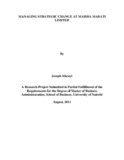| dc.description.abstract | Organizations are open systems that operate in environment that carnes with it a myriad of challenges. For them to deliver efficiently, they must learn to appreciate these ever present changes. Strategic change is triggered by the need for organizations to exploit the existing and emerging opportunities while at the same time putting up mitigative measures to deal with threats that might emerge from the very environment.
This research work set forth its objectives as being to determine how Maisha Mabati is managing strategic change and establish the challenges encountered in managing this strategic change management. The data was collected by use of a guided interview guide that targeted the senior managent level in the company. This data was later analyzed using the content analysis method. This data was then analyzed to determine its credibility, consistency, adequacy and usefulness.
It was discovered that the change management process was duly followed by the semor management enhancing this process. This was done by establishing a sense of urgency by looking at critical issues needing urgent attention. Secondly, a guiding coalition was created in which the senior managers were responsible for initiating change while forming smaller groups of oversaw the taking root of the various change programs.
Thirdly, a common vision and strategy were developed. Fourthly, this change vision was consequently communicated via several fonns including supervisor face to face with employees as well as office memoranda. Fifthly, the employees were empowered by generation of short-term wins by way of establishing their aspirations and motivating them. Sixth, the change process was planned from the top but gradually a sense of ownership by all employees was created and lastly, the new approach was anchored on culture by reviewing the departmental set-ups and reporting systems.
However the research exercise encountered a number of limitations. One was the problem of lack of clear comprehension of the research objectives of the study by some of the respondents who had to refer to the researcher for further clarification, something that caused delays. Also the collection of data led to incurring very long costs of telephone calls, e-rnails, stationary and transport costs. It is also worth mentioning that the study largely focused on the perspective of the senior managers. It would however be of more added value to obtain the views of other stakeholders including the employees of the organization, the suppliers of iron ore, major customers of the company and the Board of Directors of the organization. | en_US |

